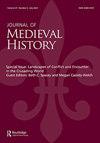维也纳圣斯蒂芬教堂与1408年的危机:中世纪建筑工地的实践理论与社会政治
IF 0.3
2区 历史学
0 MEDIEVAL & RENAISSANCE STUDIES
引用次数: 0
摘要
1408年,维也纳的政治被暴力所笼罩。哈布斯堡家族之间的王朝冲突和居民之间的内讧最终导致了处决和推翻该市政府。与此同时,该市最大的教堂的建设工作也在放缓,该教堂由该市公民政治中的主要人物监督,他们也是当年一次清洗的受害者。在这个时刻,高级政治、建筑生产和城市生活的日常实践以一种不同寻常的方式交织在一起,这对历史学家来说是非常明显的。历史学家采取了不同的史学立场,将中世纪建筑作为一种社会政治现象,基于王子和牧师的单方面行为,阶级冲突的动态,项目经理的管理技术或共享的“想象”。本文从实践理论出发,用一种新的方法来反思1408年的事件,描述建筑工地是如何被重新定义为一堆开放式的行为和言论,构成和改变了中世纪晚期的维也纳社会。本文章由计算机程序翻译,如有差异,请以英文原文为准。
St Stephen's, Vienna, and the crises of 1408: practice theory and the socio-politics of the medieval building site
ABSTRACT In 1408 Vienna's politics were traversed by violence. Dynastic conflict among the Habsburgs and internecine differences between residents culminated in executions and overthrows of the city's government. Concurrently, building work at the city's largest church – overseen by leading figures in its civic politics, also victims of one of the year's purges – slackened. It was a moment when high politics, architectural production and the everyday practice of urban life intersected in ways unusually visible to the historian. Historians have adopted different historiographical positions for positing medieval architecture as a socio-political phenomenon, based on unilateral acts of princes and churchmen, dynamics of class conflict, administrative techniques of project managers or shared ‘imaginaries’. This article reflects on the events of 1408 using a new approach, taken from practice theory, to describe how the building site, reconceptualised as an open-ended bundle of doings and sayings, constituted and transformed the late medieval Viennese social.
求助全文
通过发布文献求助,成功后即可免费获取论文全文。
去求助
来源期刊

JOURNAL OF MEDIEVAL HISTORY
MEDIEVAL & RENAISSANCE STUDIES-
CiteScore
0.60
自引率
0.00%
发文量
29
期刊介绍:
The Journal of Medieval History aims at meeting the need for a major international publication devoted to all aspects of the history of Europe in the Middle Ages. Each issue comprises around four or five articles on European history, including Britain and Ireland, between the fall of Rome and the Renaissance. The Journal also includes review articles, historiographical essays and state of research studies.
 求助内容:
求助内容: 应助结果提醒方式:
应助结果提醒方式:


